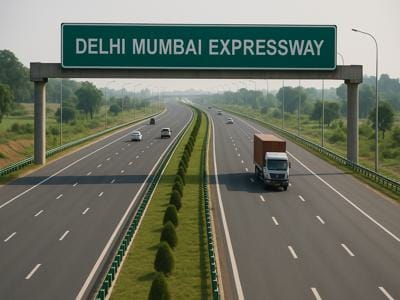Delhi Mumbai Expressway

Delhi Mumbai Expressway: Full Route, Features, Cost, Delay, and Benefits
Are you planning a road trip from Delhi to Mumbai? Usually, this journey takes around 24 hours. But very soon, this long drive will take only 12 hours, thanks to the new Delhi Mumbai Expressway. It is one of India’s biggest road projects and will change how we travel between the capital and the financial hub.
This expressway is not just about speed — it is also designed to be modern, smart, and eco-friendly. In this article, you will get full details about the Delhi Mumbai Expressway: route, cost, key features, delay in completion, and how it will help our economy and environment.
India’s Longest Expressway – 1,380 KM
The Delhi Mumbai Expressway will be India’s longest expressway, covering a distance of 1,380 kilometers. This road will connect six Indian states:
- Delhi
- Haryana
- Rajasthan
- Madhya Pradesh
- Gujarat
- Maharashtra
The total cost of the project is around ₹98,000 crore to ₹1,00,000 crore. This makes it one of the most expensive and ambitious infrastructure projects in the country.
Travel Time Will Be Reduced by Half
The biggest benefit of this expressway is time saving. Right now, travelling from Delhi to Mumbai by road takes around 24 hours. After the expressway is ready, the same journey will take only 12 hours.
This will help not only regular travellers but also transport and logistics companies, who move goods between cities. It will save fuel, reduce costs, and make delivery faster across India.
Major Cities Covered on the Route
This expressway will pass through some very important Indian cities. These cities are known for their industries, tourism, and growing economies.
Cities in Rajasthan:
- Jaipur
- Kishangarh
- Ajmer
- Kota
- Chittorgarh
- Udaipur
Cities in Madhya Pradesh:
- Bhopal
- Ujjain
- Indore
Cities in Gujarat:
- Ahmedabad
- Vadodara
- Surat
This direct connection between cities will boost the local economy, help small businesses grow, and create more jobs in smaller cities.
Wildlife-Friendly and Green Design
This is Asia’s first expressway that is specially designed to protect wildlife. It is only the second such expressway in the world.
It will include:
- 3 animal overpasses
- 5 animal underpasses
- Totaling around 7 km of road made for animals to cross safely
This unique design will help wild animals move freely without danger from vehicles. It will be very helpful in areas with forests, like parts of Rajasthan and Madhya Pradesh.
Project Cost and Who Is Building It
The total cost is nearly ₹1 lakh crore. The National Highways Authority of India (NHAI) is building this expressway under the Bharatmala Pariyojana. The work is divided into small parts or packages and different contractors are working on each section.
The expressway will also have:
- Service lanes
- Rest areas
- Toll booths
- Smart traffic monitoring systems
- Emergency helplines and signboards
Project Delay and New Timeline
The expressway was first planned to be completed by March 2024. But now, due to some delays, the new date is October 2025.
According to a Times of India report:
- 87 km of roadwork in Gujarat is delayed
- One stretch of 35 km has completely stopped
- Two more stretches are only 7% and 35% completed
So now experts believe that the full expressway may only be ready by 2027.
Benefits for Economy and People
This expressway is not just for cars and trucks. It will help the Indian economy in many ways:
- Faster goods movement will reduce logistics costs
- Tourism will grow in cities like Jaipur, Udaipur, Indore, and Vadodara
- More jobs will be created in small cities and towns
- Less pollution, as vehicles will spend less time on the road
- Better road safety, due to wide lanes and modern design
It will also help in reducing traffic on existing highways like NH-48 and improve road connectivity between North and West India.
Conclusion
The Delhi Mumbai Expressway is a big step towards building a modern India. Once ready, it will change road travel forever — faster, safer, greener, and more comfortable.
Even though there are some delays, this expressway will soon become a symbol of India’s growth in infrastructure. For regular travellers, tourists, truck drivers, and businessmen, this expressway will bring great convenience and opportunity.
So next time you think of travelling from Delhi to Mumbai by road, you can look forward to a smooth 12-hour ride through one of the most advanced highways in the country.
